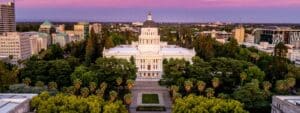By Noreen Evans, Jake Mackenzie, and Dee Swanhuyser
We all want economic growth and a strong economy. We also like our open space and our farmlands. The notion that we must sacrifice our environment to have a strong economy is false.
As a result of forward- thinking growth policies adopted by county voters, our cities and the Board of Supervisors nearly 20 years ago, our open space and rural landscape are the primary reasons that so many of us want to live here, why people come here to visit and why our economy thrives.
By designating nearly 17,000 acres of natural and working lands as community separators, the county has prevented housing tracts and shopping malls from sprawling into our precious green places. By safeguarding adjacent unincorporated lands, community separators protect the urban growth boundaries around Sonoma County’s cities.
But now we are at a crossroads.
Voter protections for community separators, which were approved by more than 70 percent of the voters nearly 20 years ago, expire at the end of 2016. We need to renew and strengthen these voter protections, or we risk opening the door to new development that could threaten what makes Sonoma County special.
A recent poll commissioned by Greenbelt Alliance shows strong support from Sonoma County voters: More than 75 percent would vote yes today on a ballot measure to renew and expand community separators. And 67 percent would view their supervisors more favorably if they placed such a measure on the November 2016 ballot.
The Sonoma County Board of Supervisors will hold a public workshop on community separators at 10:30 a.m. Dec. 15 in the supervisors’ chambers.
We urge everyone who cares about protecting greenbelts to speak up for renewing, strengthening and updating community separators.
The purpose of community separators is three-fold: They serve as green buffers between our cities and towns, limit urban development and preserve the rural charm of Sonoma County’s landscape.
Community separators also sustain agriculture, waterways, groundwater and recharge areas, wildlife corridors, grasslands and forests. They protect clean air and water and contribute to public health and climate resiliency.
That’s why Greenbelt Alliance and Sonoma County Conservation Action are working with the Board of Supervisors and collaborating with environmentalists, farmers, housing advocates and communities to lead the way to a new voter mandate that renews and strengthens community separators.
A simple renewal of the existing community separators makes sense and is not controversial. But we also need to address the growing development threats to greenbelts and agriculture along the urban edges of our growing cities. Project by project, housing subdivisions and commercial development are encroaching on the community separators.
To slow this development creep, we are urging the Board of Supervisors to implement the community separator designations that are already part of the 2020 Sonoma County general plan.
As the land-use bible for the county, the general plan calls for community separator designations for priority greenbelts identified by the Agricultural Preservation and Open Space District.
The general plan also identifies the need for community separators around Penngrove and for lands between Cloverdale and Healdsburg. Community separator designation should also be considered between unincorporated communities in the future.
The public process to implement the general plan’s priority community separators was started five years ago, but then postponed as a result of belt-tightening during the recession. Now is the time to implement these important landscape protections and extend the voter protections.
Sonoma County faces a housing crisis. But sprawling into the greenbelts is not the solution — and is unnecessary.
In fact, our cities and towns have plenty of room to accommodate existing as well as new residents and workers.
For example, in Sonoma County, more than 10,000 units of housing have been approved but never built due to a variety of factors such as the recession and lack of affordable housing funding.
Greenbelt Alliance supports a multi-pronged approach to encourage building new and affordable housing near transit and downtowns.
Sonoma County can have it all. Protecting our greenbelts and investing in our communities will keep our vibrant economy alive.
Noreen Evans, a former member of the state Senate, and Jake Mackenzie, a member of the Rohnert Park City Council, are both board members of Greenbelt Alliance. This piece is also authored by Dee Swanhuyser, a trails and open space advocate who has lived in west Sonoma County for 36 years.
This article was originally published by The Press Democrat.




